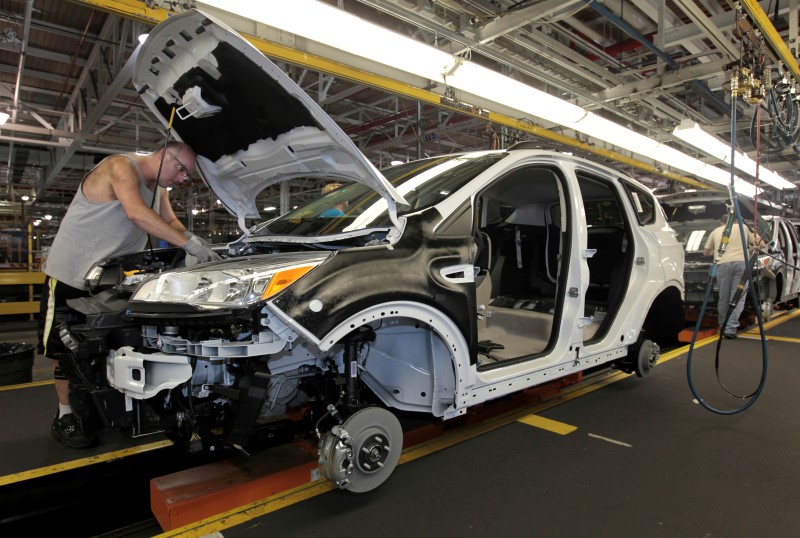By Lucia Mutikani
WASHINGTON (Reuters) - New orders for U.S. manufactured capital goods rose for a second straight month in July as demand for machinery and a range of other products picked up, offering a tentative sign that a business spending downturn was starting to ease.
The economic outlook also was boosted by another report on Thursday showing an unexpected drop in the number of Americans filing for unemployment benefits last week, indicating sustained labor market strength.
Together, the data support the view that the Federal Reserve will raise interest rates in December. Fed Chair Janet Yellen could give guidance on the near-term outlook for U.S. monetary policy when she speaks on Friday at a global central bankers' conference in Jackson Hole, Wyoming.
"This kind of data are consistent with what the Fed is looking for in terms of the labor market and economic growth. If we get more data like this, that will suggest we are likely to see an interest rate increase, most likely in December," said Gus Faucher, senior economist at PNC Financial Services Group (NYSE:PNC).
The Commerce Department said non-defense capital goods orders excluding aircraft, a closely watched proxy for business spending plans, increased 1.6 percent last month, the largest gain since January.
These so-called core capital goods orders advanced 0.5 percent in June. The rise in July marked the first back-to-back gain since January 2015. Economists polled by Reuters had forecast core capital goods orders rising only 0.3 percent last month.
There were hefty increases in orders for machinery, primary metals, fabricated metal products, computers and electronic products, as well as electrical equipment, appliances and components.
U.S. financial markets were little moved by the data as investors were focusing on Yellen's upcoming speech. The dollar (DXY) was trading marginally lower against a basket of currencies, while U.S. stocks were largely unchanged. Prices for U.S. government bonds fell slightly.
The U.S. central bank raised interest rates at the end of last year for the first time in nearly a decade, but has held them steady so far in 2016 amid concerns over persistently low inflation. Most economists expect another rate hike in December.
After contracting since the fourth quarter of 2015, business investment has caught the attention of Fed officials, with some viewing it as posing a downside risk to economic growth. Investment has declined in part as companies slashed capital spending budgets in response to lower oil prices.
That in turn put pressure on manufacturing, which has also been undercut by a strong dollar, weak global demand and a U.S. inventory correction. July's increase in core capital goods orders followed a rise in oil and gas drilling activity in recent months.
SOFT BUSINESS SPENDING
Still, business investment is likely to be tepid in the third quarter amid uncertainty over the global economy after Britain's decision to leave the European Union and ahead of the Nov. 8 U.S. presidential election, economists say.
"The solid gains in the last two months set the stage for capital spending to become a net contributor to growth again in the second half of the year," said Anthony Karydakis, chief economic strategist at Miller Tabak in New York.
"The potential softening in the euro zone economy following the Brexit vote may, at the margin, limit the extent of the comeback of capital spending in the U.S."
Heavy machinery maker Caterpillar (N:CAT) last month lowered its 2016 forecast, citing sluggish demand in mining and other industries. Weak business spending contributed to holding down economic growth to 1.0 percent in the first half of 2016.
With demand for core capital goods orders rising briskly last month, overall orders for durable goods - items ranging from toasters to aircraft that are meant to last three years or more - surged 4.4 percent in July. Durable goods inventories rose last month after six straight months of decline.
Shipments of core capital goods, which are used to calculate equipment spending in the government's gross domestic product measurement, fell 0.4 percent last month after decreasing 0.5 percent in June.
But labor market strength should support consumer spending and cushion the blow on the economy from weak business investment. The Atlanta Fed currently forecasts the economy will grow at 3.4 percent annualized rate in the third quarter.
In a separate report on Thursday, initial claims for state unemployment benefits slipped 1,000 to a seasonally adjusted 261,000 for the week ended Aug. 20. It was the third straight weekly decline in claims.
Economists had forecast first-time applications for jobless benefits rising to 265,000 in the latest week. Claims have now been below 300,000, a threshold associated with a strong labor market, for 77 straight weeks. That is the longest such stretch since 1973, when the labor market was much smaller.

"The ongoing decline in initial claims indicates substantial underlying strength in labor markets," said Rob Martin, an economist at Barclays (LON:BARC) in New York. "Workers are not losing their jobs in large numbers and those workers who do get laid off are likely finding employment."